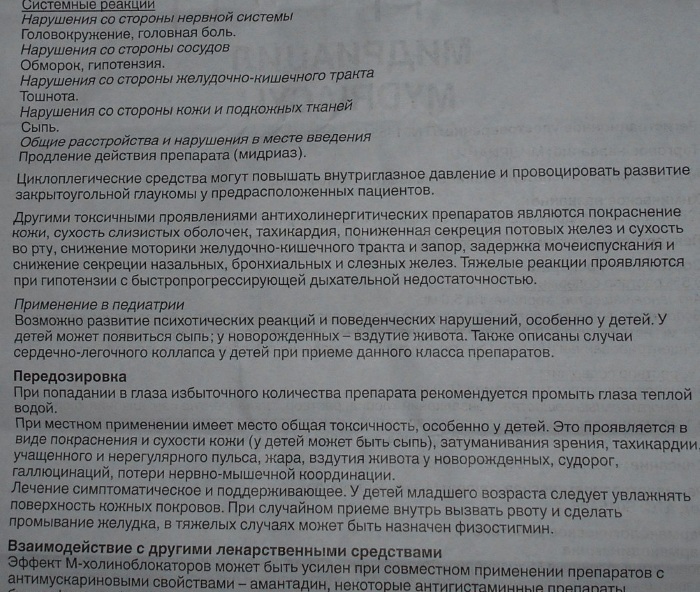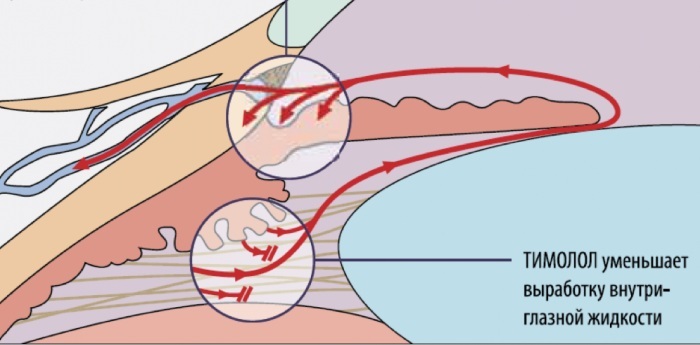Eye drops Potassium iodide - a remedy for the treatment of cataracts. They are also used for intraocular hemorrhage, inflammation in the conjunctiva and in the cornea caused by fungal infections. The medication is well tolerated, sold in convenient dropper containers at an affordable price.
Record content:
- 1 Forms of release and composition of the drug
- 2 Pharmacological properties
- 3 Pharmacodynamics and pharmacokinetics
- 4 Indications for use
- 5 Contraindications
- 6 At what age can the drug be used?
- 7 Instructions for use, dosage of the drug
- 8 Side effects
- 9 Overdose
- 10 special instructions
- 11 Drug interactions
- 12 Analogs
- 13 Terms, conditions of sale and storage
- 14 Price in pharmacies in Moscow, St. Petersburg, regions
- 15 Video about drops of Potassium iodide
Forms of release and composition of the drug
The medicinal drug Potassium iodide for use in ophthalmology is sold in the form of a 2% and 3% solution. The main component of this drug is potassium iodide. Excipients: chlorhexidine, Trilon B, sodium thiosulfate.
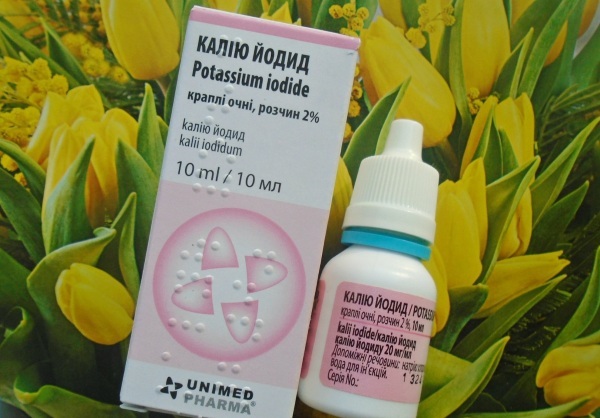
Potassium iodide - eye drops, which are sold in glass, plastic bottles (5 and 10 ml) with convenient drip dispensers. The 3% solution is also available in 200 ml vials.
The medicine is produced in Russia, Ukraine, and also by a Slovak pharmaceutical company.
Pharmacological properties
The drug has proteolytic, antiseptic and anti-sclerotic properties, reduces blood viscosity. The proteolytic action of the drops is aimed at splitting the pathologically modified proteins of the lens of the eye.
This property provides a therapeutic effect when the lens (biological lens of the eye) becomes clouded due to protein denaturation. In this eye pathology, called "cataract", proteins lose their natural properties. As a result, the lens becomes cloudy, the eyes lose light sensitivity, color rendition is impaired, and as a result, vision deteriorates significantly.
The antiseptic properties of the drug are due to the disinfecting effect of drops on the membranes of the eye - this is a protection against pathogenic microorganisms.
Potassium iodide is especially effective against fungal infections that cause inflammation of the conjunctiva (the protective membrane that covers the eye outside and eyelids from the inside), as well as the cornea - convex, the front of the eyeball, which is responsible for the normal passage of light flow. Potassium iodide is also effective as an adjuvant therapy for syphilitic eye damage.
The anti-sclerotic effect is manifested by the protection of the ocular arteries from atherosclerosis damage, which occurs as a result of deposits of "bad" cholesterol on the inner lining (intima) of the vessels. The lumen of the arteries is clogged with atherosclerotic plaques, which disrupts the blood supply to the eye.
Pharmacodynamics and pharmacokinetics
Iodine preparations, including potassium iodide, affect the thyroid gland. They are able to briefly reduce the production of hormones, causing the antithyroid effect. They also thicken its tissue structure, prevent hyperplasia - excessive growth.
The action of ophthalmic drops of Potassium iodide is local, aimed at improving the condition of the organs of vision. The drug reduces the growth of the population of pathogenic fungi, promotes the resorption of denatured lens proteins and infiltrates.
The absorption of drops into the general bloodstream is insignificant. The effect on the thyroid gland when using ophthalmic drops with microdoses of iodine occurs with prolonged use and increased susceptibility to medications containing iodine.
Indications for use
Potassium iodide eye drops are used for the following pathologies:
- cataract (it is preferable to use drops at the initial stage);
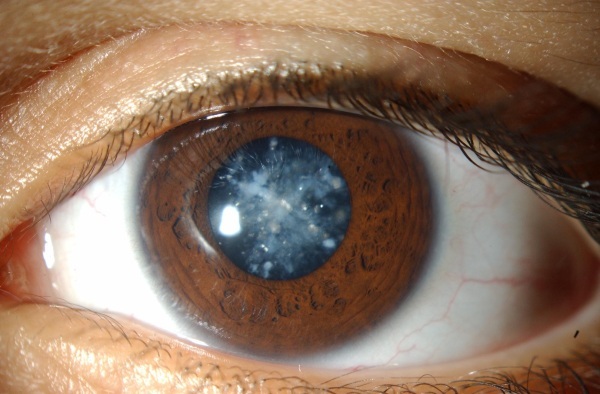
- keratitis (inflammation of the cornea);
- fungal conjunctivitis;
- atherosclerosis of the retinal arteries;
- age-related, degenerative processes;
- atrophic changes in the optic nerve in syphilis;
- keratoconjunctivitis (inflammation that affects both the cornea and the conjunctiva);
- intraocular hemorrhage (hemophthalmos).
Damage to the choroid can be due to fungal keratitis. Inflammation of the cornea leads to the appearance of a leucorrhoea and a significant deterioration in vision. Like cataracts, it can lead to blindness - potassium iodide helps prevent this process (with combination therapy). The medication also speeds up recovery from fungal inflammatory eye pathologies.
Contraindications
Potassium iodide - eye drops that have contraindications:
- hypersensitivity to iodine (the medication can cause allergic manifestations in the form of burning sensation, conjunctival redness, swelling);
- hemorrhagic diathesis;
- pathology of the thyroid gland (dysfunction, benign, as well as malignant neoplasms);
- furunculosis;
- pulmonary tuberculosis;
- pyoderma;
- nephritis.
Acute inflammation of the kidneys is a contraindication, since disruption of their work prevents the elimination of iodine.
At what age can the drug be used?
Potassium iodide drops are used in pediatric therapy. It is not used in the treatment of newborns. The dosage for children should be checked with a doctor.
Instructions for use, dosage of the drug
Ophthalmic drops should be instilled in 1-2 drops, under the lower eyelid, several times a day. If no dropper container is available, a clean pipette should be used.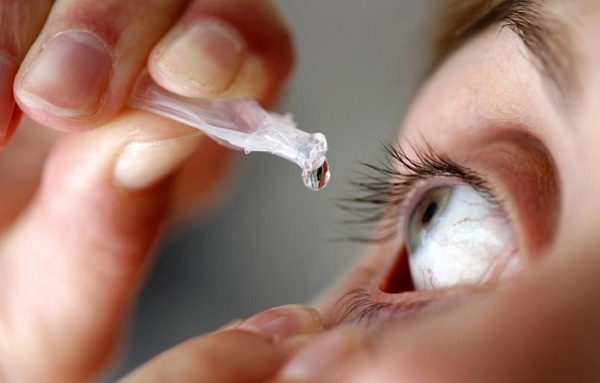
The course of treatment is 10-14 days.
It is recommended to remove contact lenses before using the drug and put them on after 15–20 minutes. When using other eye drops, the interval between instillations must be observed - 5 minutes.
Side effects
With local use of the medication, the following side effects are possible:
- inflammation of the mucous membranes of the eye (non-infectious) - redness, burning, swelling;
- nasal congestion as a result of swelling of the mucous membrane, runny nose;
- lacrimation.
In rare cases, Quincke's edema may occur.
If side effects appear that do not go away for a long time on their own, for example, a burning sensation, it is recommended to cancel the use of the medication.
Overdose
Iodine is excreted by the kidneys from the body for a long time. The risk of overdose may arise with a significant increase in dosage over a long period of time, non-compliance with the method of administration. Also, with the active penetration of the drug into the general bloodstream through the mucous membrane in the nasal cavity, where the solution enters.
A distinctive sign of an overdose and systemic intoxication of the body will be the staining of the oral mucosa in brownish shades.
Manifestations of iodine toxicity:
- heart rhythm disturbance;
- disorientation;
- feeling of numbness, tingling in the limbs;

- feeling of weakness.
With hypersensitivity to iodine, as well as when combined with other iodine-containing medications (with prolonged use) the occurrence of iodism is possible - iodine poisoning (the condition is not allergy).
Symptoms of iodism:
- metallic taste;
- headache;
- burning sensation in the throat;
- stomach ache;
- nausea, vomiting may develop;
- salivation;
- anxiety, excessive nervous excitability;
- swelling of the eyelids;
- swelling of the vocal cords;
- redness of the conjunctiva;
- rhinitis;
- hives;
- fever;
- skin irritation, dermatitis.
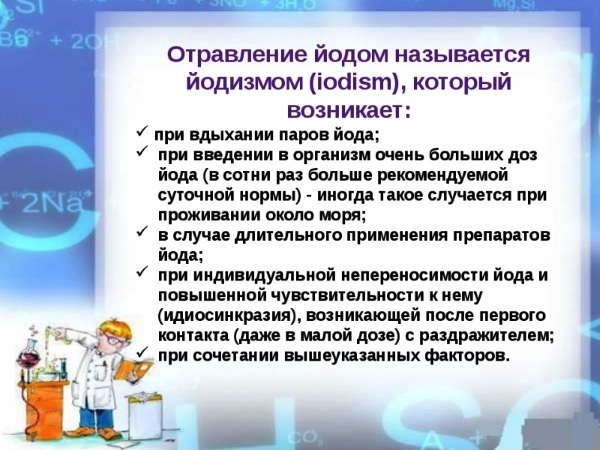
With the correct use of drops of Potassium iodide, such cases are rare. Poisoning more often occurs during therapy with iodine-containing drugs in combination with regular inhalation of iodine vapors at work.
Not very pronounced symptoms of poisoning do not require medical attention. In acute and severe poisoning (for internal use), the stomach is washed with a starch solution until the bluish tint of the vomit disappears. Sodium thiosulfate is used for detoxification. Give a drink a decoction of rice or rolled oats.
With prolonged overdose, hyperthyroidism (thyrotoxicosis) may develop - hypersecretion of hormones in the thyroid gland.
With symptoms of iodism, iodine-containing drugs are canceled, and the treatment regimen is adjusted.
special instructions
Potassium iodide (eye drops) is recommended for use after checking the thyroid gland. They are prescribed with caution to people with severe renal failure to reduce the risk of hyperkalemia (monitoring of potassium levels is recommended).
Iodine can enter the fetus through the placenta, which can lead to disruption of the function of the thyroid gland in the fetus, an increase in its size. Therefore, iodine-containing preparations during pregnancy are used only under constant medical supervision.
Iodine is also found in breast milk. With an overabundance of this element, the baby may develop hyperthyroidism. It is also possible for a child to develop a rash. After applying the drops, blurred vision occurs, which disappears on its own after 15 minutes. During this period, it is recommended to refrain from driving.
Drug interactions
With the simultaneous combination of potassium iodide, potassium-sparing diuretics, ACE inhibitors, hyperkalemia may occur - an increased content of potassium ions in the blood. This pathological condition is dangerous because it can disrupt the heart rhythm and cause arrhythmias.
The simultaneous long-term use of lithium (antidepressants) with medications increases the risk of hypothyroidism and goiter.
Joint use of potassium iodide with antithyroid medications (potassium perchlorate) is allowed.
Analogs
Ophthalmic agents - analogues of the medication Potassium iodide - are used to reduce the symptoms of cataracts and inflammation.
| Table of analogs of Potassium iodide (drops) | |
| Name of medication | Description |
| Vita-Yodurol | Normalizes blood supply to the eye and metabolism in the lens at the cellular level in case of cataract. |
| Oftan katakhrom | Combined medication. Improves metabolism in the lens of the eye. It is used to treat cataracts of various origins. |
| Quinax | Medication for the treatment, prevention of lens opacity.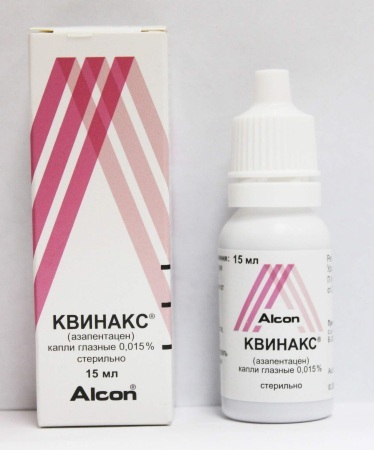
|
| Taurine | It is used in the complex therapy of cataracts, corneal lesions, and glaucoma.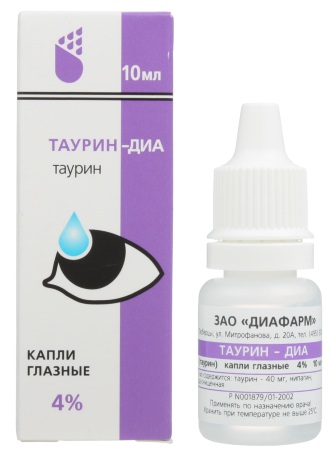
|
| Cataxol | Treatment of cataracts of any origin. |
| Lacrisifi | Ophthalmic drug with a wide spectrum of medicinal action. It has a keratoprotective effect - protecting the cornea of the eye. |
| Vitafacol | Combined drug to prevent the development of cataracts. |
| Okovirin | The drops contain a complex of natural plant bioactive substances. The drug is used as a prophylaxis for age-related degenerative processes in the retina and in the cornea. |
The drugs improve blood supply, metabolism in the lens, and have antioxidant properties.
Terms, conditions of sale and storage
The shelf life is 3 years. After opening, the medication can be stored for 28 days. It is recommended to keep the medicine in a darkened and inaccessible place for babies, at t up to 25 ° C.
Potassium iodide in the form of an ophthalmic solution is dispensed in pharmacies, in accordance with the instructions, - with a prescription.
Price in pharmacies in Moscow, St. Petersburg, regions
The price of a medication in Moscow is from 160 rubles per bottle. In St. Petersburg - from 100 rubles. In the regions - from 30 rubles. (simple glass bottle 10 ml).
Eye drops help improve vision in case of clouding of the lens, accelerate recovery from hemorrhages, as well as fungal eye infections. Potassium iodide is available without a prescription, but has a number of contraindications. Therefore, it is recommended to consult an ophthalmologist before use.
Article design: Vladimir the Great
Video about drops of Potassium iodide
Drug review:


